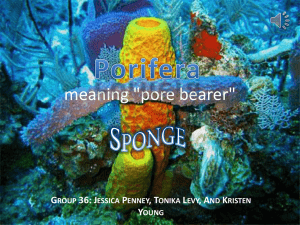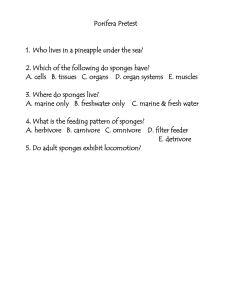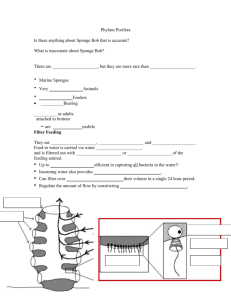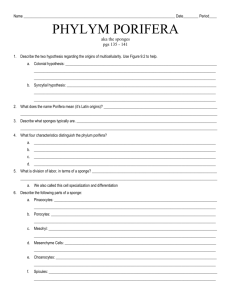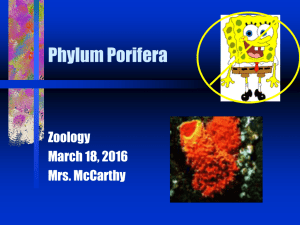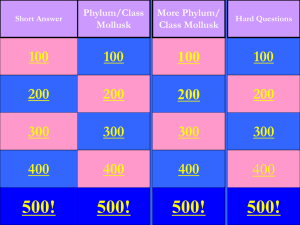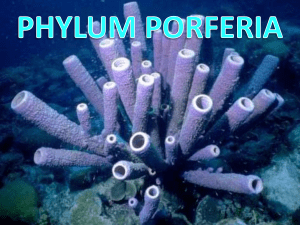Chapter 6 Sponges
advertisement
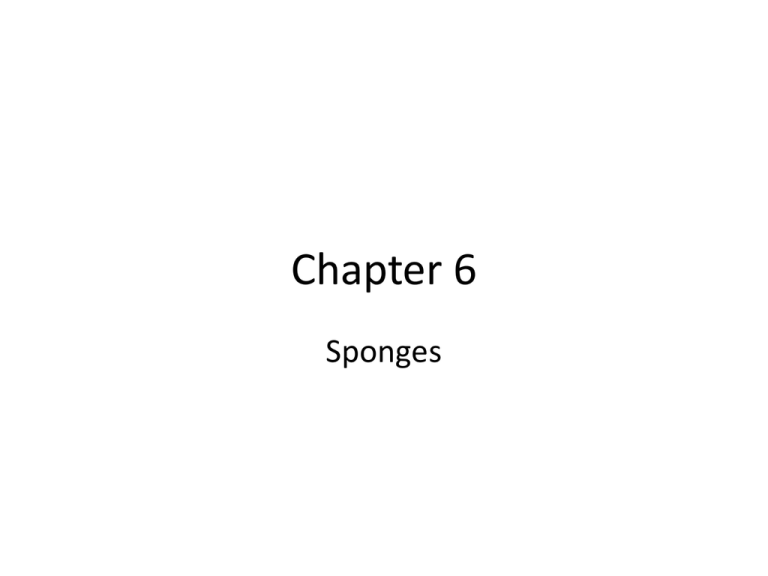
Chapter 6 Sponges Origin of Metazoa • Evolution of the Metazoa – Evolution of eukaryotic cell followed by diversification – Modern descendants • Protozoa, plus multicellular plants, animals, and fungi – Multicellular animals • Referred to collectively as metazoans – Grade Parazoa 6-3 Phylum Porifera General Features • Sessile sponges are filter feeders • Porifera means “pore-bearing” - bodies perforated by many pores • Skelton is composed of spicules • Sponges can regenerate • Body is efficient aquatic filter • Approximately 15,000 species of sponges – Most are marine • Few live in brackish water, 150 in fresh water 6-4 Phylum Porifera • Marine sponges found in all seas at all depths and vary greatly in size • Many species are brightly colored because of pigments in dermal cells • Some appear radially symmetrical but many are irregular in shape • Some stand erect, some are branched, and some are encrusting 6-5 6-6 Phylum Porifera • Fossil record of sponges dates back to the early Cambrian • Living sponges traditionally assigned to 3 classes: Calcarea, Hexactinellida, and Demospongiae – Members of Calcarea typically have calcium carbonate (calcareous) spicules with one, three, or four rays – Hexactinellids are glass sponges with six-rayed siliceous spicules – Members of Demospongiae have siliceous spicules, spongin fibers, or both • A fourth class, Sclerospongiae, was formed to contain sponges with massive calcareous skeleton and siliceous spicules 6-7 Figure 6_02 Phylum Porifera • Growth patterns often depend on characteristics of the environment-substrate, direction and speed of water current, space • Many animals live as commensals or parasites in or on sponges-crabs, nudibranch, fish – Sponges grow on a variety of other living organisms such as barnacles, coral, and molluscs • Few predators – Sponges may have an elaborate skeletal structure and often have a noxious odor 6-9 Sponge growing on coral 6-10 Phylum Porifera Form and Function • Body openings consist of small incurrent pores or dermal ostia and water outlets or osculum • Inside the body – Water is directed past the choanocytes where food particles are collected – Choanocytes (flagellated collar cells) line some of the canals • Keep the current flowing by beating of flagella • Trap and phagocytize food particles passing by 6-11 Phylum Porifera • Types of Canal Systems – Asconoids: Flagellated Spongocoels • Simplest body form • Small and tube-shaped • Water enters a large cavity, the spongocoel – Lined with choanocytes – Choanocyte flagella pull water through – All Calcarea are asconoids » Leucosolenia and Clathrina are examples. 6-12 Figure 6_04 Class Calcarea 6-14 Phylum Porifera – Syconoids: Flagellated Canals • Resemble asconoids but larger with a thicker body wall • Wall contains choanocyte-lined radial canals that fold back and forth to make canals then empty into spongocoel – Water enters radial canals through tiny openings called prosopyles, then to radial canals, then apopyle to spongocoel • Spongocoel is lined with epithelial cells rather than choanocytes • Food is digested by choanocytes 6-15 6-16 Phylum Porifera • Leuconoids: Flagellated Chambers – Most complex and are larger with many oscula – Clusters of flagellated chambers are filled from incurrent canals, and discharge to excurrent canalsno spongocoel – Most sponges are leuconoid – The leuconoid system • Evolved independently many times in sponges – System increases flagellated surfaces compared to volume • More collar cells can meet food demands • Large sponges filter 1500 liters (400 gals) of water per day 6-17 Phylum Porifera • Types of Cells – Sponge cells are arranged in a gelatinous extracellular matrix, mesohyl (filler) • Connective “tissue” of sponges • Absence of organs requires that all fundamental processes occur at the level of individual cells – Only visible activities of sponges are • Slight alterations in shape, local contraction, propagating contractions, and closing and opening of incurrent and excurrent pores • Movements occur very slowly 6-18 6-19 Phylum Porifera –Pinacocytes • Form pinacoderm • Flat epithelial-like cells • Somewhat contractile • Some are myocytes that help regulate flow of water 6-20 Phylum Porifera – Choanocytes • Oval cells with one end embedded in mesohyl • Exposed end has one flagellum surrounded by a collar • Collar consists of adjacent microvilli – Forms a fine filtering device to strain food – Particles too large to enter collar are trapped in mucous – Moved to the choanocyte and phagocytized – Food engulfed by choanocytes is passed to archaeocytes for digestion 6-21 6-22 6-23 Phylum Porifera –Archaeocytes • Move about in the mesohyl • Phagocytize particles in the external epithelium • Can differentiate into any other type of cell – Sclerocytes secrete spicules – Spongocytes secrete spongin – Collencytes secrete fibrillar collagen – Lophocytes secrete collagen 6-24 Phylum Porifera • Skeletal structure of a sponge can be fibrous and/or rigid – If present, rigid skeleton consists of calcareous or siliceous spicules – Fibrous portion • Collagen protein fibrils in intercellular matrix • Several types of one form of collagen, spongin, exists – Composition and shape the spicules • Forms the basis of sponge classification 6-25 Phylum Porifera • Desmospongia-spongin, siliceous spicules or both • Calcarea-spicules 1,3 or 4 rays • Hexactinellida-spicules 6 rays • Sclerospongiae-spicules 6-26 6-27 6-28 Phylum Porifera • Sponges consume detritus, plankton, and bacteria • Digestion is intracellular • No respiratory or excretory system-diffusion, Contractile vacuoles in freshwater sponges • No nervous system • Excellent filtering ability, some sponges can crawl 6-29 Phylum Porifera • Sexual Reproduction – Most are monoecious-male and female sex cells in one individual • The free-swimming larva of sponges is a solid parenchymula 6-30 6-31 Phylum Porifera – Asexual reproduction can occur by bud formation or fragmentation • External buds-budding – Small individuals that break off after attaining a certain size • Internal buds or gemmules – Formed by archaeocytes that collect in mesohyl – Coated with tough spongin and spicules – Survive harsh environmental conditions – Sponges have a great ability to regenerate lost parts and repair injuries – Regeneration following fragmentation 6-32 Gemmule formation 6-33 Phylum Porifera • Classification – Class Calcarea-having spicules – Class Hexactinellida-glass sponge – Class Demospongiae-horn sponges like the bath sponges also freshwater sponges – Class Sclerospongiae-coralline or tropical reef sponges 6-34 Phylum Porifera Class Calcarea (Calcispongiae) • Calcareous sponges with spicules of calcium carbonate • Spicules are straight or have three or four rays • Most are small with tubular or vase shapes • Many are drab in color, but some are bright yellow, green, red, or lavender • Leucosolenia and Sycon are marine shallow-water • Asconoid, syconoid and leuconoid body forms 6-35 Phylum Porifera Class Hexactinellida (Hyalospongiae) • • • • Glass sponges with six-rayed spicules of silica Nearly all are deep-sea forms Most are radially symmetrical Stalks of root spicules attach them to substrate 6-36 Phylum Porifera Class Demospongiae • Contains 80% of living sponge species • Spicules are siliceous but not six rayed – Absent or bound together by spongin • Leuconoid body form • All marine except for Spongillidae, the freshwater sponges • Freshwater sponges – Widely distributed in well-oxygenated ponds and springs – Flourish in summer and die in late autumn • Leave behind gemmules • Marine demosponges – Highly varied in color and shape • Bath sponges – Lacks siliceous spicules, have spongin skeletons 6-37 Figure 6_13a Figure 6_13b Figure 6_13c Phylum Porifera • Phylogeny and Adaptive Diversification – Sponges appeared before the Cambrian – Glass sponges expanded in the Devonian – One theory • Sponges arose from unicellular choanoflagellates • However, some corals and echinoderms also have collar cells, and sponges acquire them late in development – Molecular rRNA evidence suggests • Common ancestor for choanoflagellates and metazoans • Sponges and Eumetazoa are sister groups with Porifera splitting off before radiates and placozoans 6-41 Phylum Porifera • Adaptive Diversification – Poriferans are a highly successful group – Diversification centers on their unique water-current system and its degree of complexity – New feeding mode has evolved for a family of sponges found in deepwater caves • • • • • • Tiny hook-like spicules cover body Spicule layer entangles crustaceans Filaments of the sponge body grow over prey Carnivores, not suspension feeders Contain siliceous spicules, but lack choanocytes and internal canals Illustrates the non-directional nature of evolution 6-42

